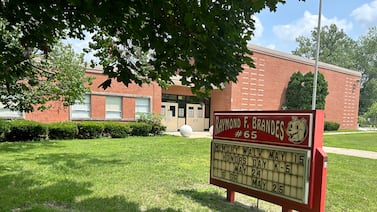Sign up for Chalkbeat Detroit’s free daily newsletter to keep up with the city’s public school system and Michigan education policy.
Many Michigan schools are still not being equitably funded, despite the state increasing dollars for at-risk students in recent years, according to a new analysis.
Only 55% of schools in Michigan’s 25 largest districts showed patterns of equitable per-pupil state spending in the 2018-19 school year, according to the analysis by the Citizens Research Council of Michigan.
The continuing inequities occurred because funding decisions for individual schools are made by school boards and administrators, not the state, the report said.
As lawmakers consider putting more money into at-risk funding for the 2024-25 school budget, researchers said they should consider adding more financial transparency and accountability tied to the dollars.
“I think it’s important because in Michigan, the state controls the purse strings, in terms of the funding model we have set up,” said Craig Thiel, research director of the CRC of Michigan. “But, are those dollars actually getting allocated down to the school where the children who need them attend? That’s a big picture policy question lawmakers have to ask.”
Amber Arellano, executive director of the non-partisan advocacy policy group Education Trust-Midwest, said the same pattern outlined in the report has been seen in other states. The organization, which often advocates for Michigan to invest more in at-risk funding, also calls for a “robust system of fiscal transparency and accountability,” said Arellano.
“Such a system will ensure that critical investments for students with the greatest needs will actually reach them in their schools and classrooms,” she added.
The analysis, which includes funding from the 2018-19 school year, was done with information from new federal data reporting requirements in the Every Student Succeeds Act, which requires states to provide per-student spending at the school level for every district. Previously, states were only required to give district-level data.
Though 2022-23 funding data is available, it is not included in the CRC report. The analysis only looks at 2018-19 because it was the last full school year before the pandemic and gives a baseline for funding expenditures before the onslaught of millions of dollars in federal COVID relief funding.
The report did not list the districts or the schools included in the analysis.
The CRC plans on analyzing recent years that included big increases to at-risk funding and the new “opportunity index” formula.
In the 2023-24 state school budget, an additional $1 billion in at-risk funding was allocated to districts through the opportunity index, which gives more at-risk dollars to districts serving communities with higher concentrations of poverty.
Previously, the state gave the same amount of per-pupil funding to all students considered to be at risk, regardless of the levels of poverty in their districts.
As the state budget cycle wraps up, there are proposals to invest more in the opportunity index – a step that advocates say would begin to reverse years of inequitable school funding in Michigan.
The analysis includes a sample of Michigan’s largest public school systems and districts with the highest concentrations of students living in impoverished communities.
It looks at equitable rather than equal funding, meaning it seeks to find out whether districts gave additional dollars to schools in poorer communities.
The analysis calculated patterns of equitable per-pupil spending by creating three ratios. One ratio represents the percentage of students enrolled who were identified by the state as “economically disadvantaged” relative to the district’s overall percentage of students in that population. The other ratios represent per-pupil state and local spending for each school and one for overall per-pupil spending in the district.
Researchers used the ratios to calculate whether districts were directing more money to the schools with higher percentages of economically disadvantaged students.
Of the 553 schools included in the analysis, 302, or about 55%, showed equitable patterns of per-student spending. When the analysis included federal dollars for poverty, the percentage increased slightly, to 57%.
Thiel said it’s still unclear why the funding disparities are happening. But there are a couple of possibilities, including personnel costs and using at-risk dollars to replace general funds.
“It’s generally the case that more senior, more well-compensated teachers gravitate to those schools where student learning is not as challenging,” said Thiel. “The younger teachers are showing up in schools that have students with the greatest needs academically.”
It might appear to administrators that they are staffing schools equitably, with more teachers at higher-need schools.
“But if a teacher’s salary in the school where student learning is not challenging is $100,000 and the two teachers in the school where it is challenging each make $40,000, the resources aren’t showing up in that school,” said Thiel.
District officials also could be using at-risk funding to supplant general fund dollars that would have gone to schools serving kids in impoverished communities.
“It’s a new dollar coming into the district, but at the school level, instead of targeting it to the at-risk population that generated that money, the dollar that was already planned to go there is backed out,” he said. “So, the net effect at that school may be zero.”
Thiel said as the legislature looks to increase at-risk funding again this year, lawmakers should consider rules to restrict such use of the dollars.
Arellano said Ed Trust-Midwest has called for a requirement that at least 75% of targeted funds be spent at schools where qualifying students attend. They have also advocated for public and easily accessible data on school-level spending of dollars directed to at-risk and English language learners.
Hannah Dellinger covers K-12 education and state education policy for Chalkbeat Detroit. You can reach her at hdellinger@chalkbeat.org.







